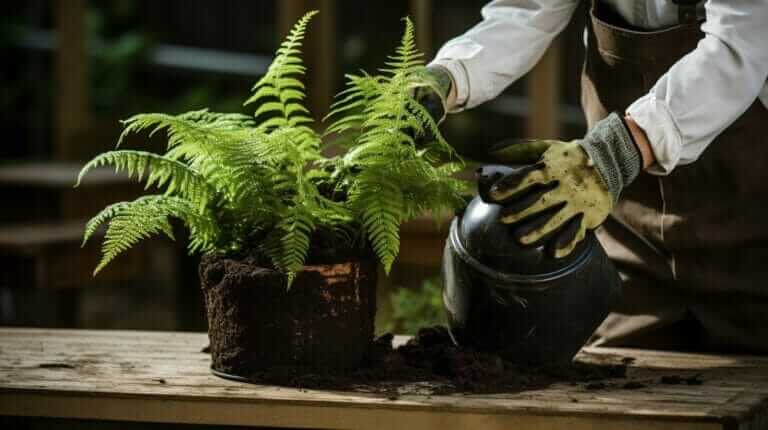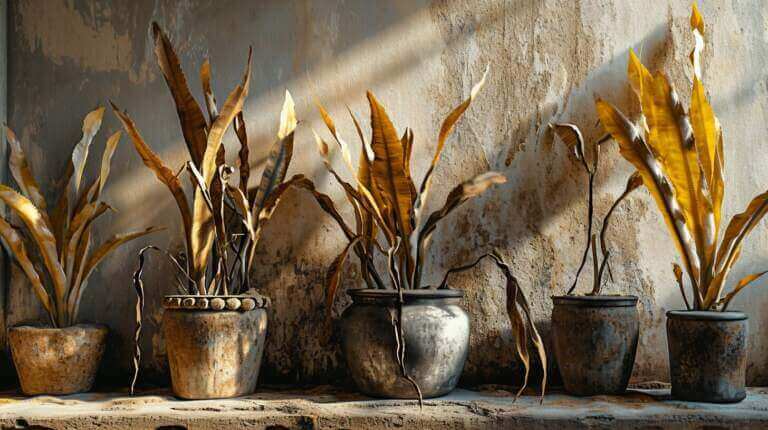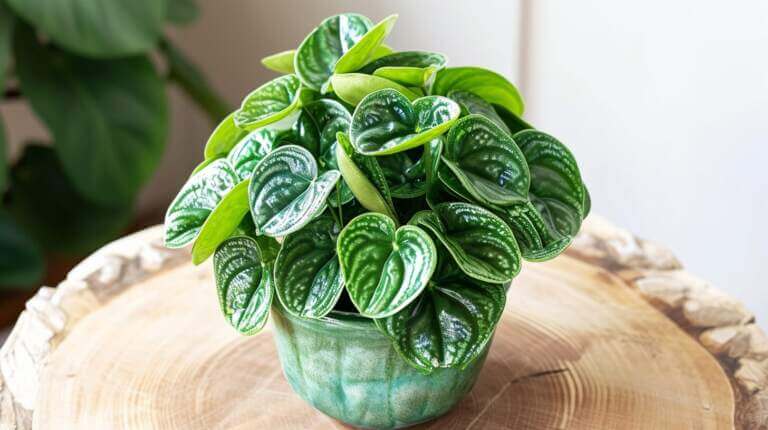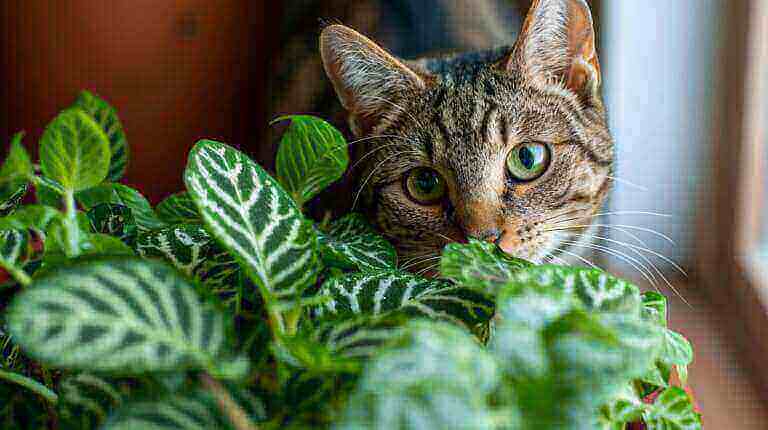Hello there! If you’re looking to add a touch of vibrant greenery to your indoor space, you’re in the right place. In this beginner’s guide, I’ll walk you through everything you need to know about growing and caring for the stunning Tradescantia Zebrina, also known as the Wandering Jew plant. Whether you’re new to indoor gardening or have some experience under your belt, you’ll find the information you need to cultivate lush and gorgeous Tradescantia Zebrina plants right in your own home.
Key Takeaways:
- Growing Tradescantia Zebrina is perfect for beginners and experienced indoor gardeners alike.
- Tradescantia Zebrina is native to Central and South America and can become invasive in certain regions.
- The plant features striking zebra-patterned leaves and produces lovely pink flowers.
- There are different varieties of Tradescantia Zebrina, each with unique colors and characteristics.
- Proper planting, care, pruning, and propagation techniques will ensure your plant thrives.
The Natural Habitat of Tradescantia Zebrina
Tradescantia zebrina, commonly known as wandering Jew or inch plant, is native to Central and South America, specifically Mexico, Colombia, and the Caribbean. It thrives in lightly forested and moist areas, where it can quickly spread and form dense mats. However, its vigorous growth has led to its classification as an invasive plant in some regions, such as Hawaii, Brazil, and Australia.
In its natural habitat, Tradescantia zebrina plays an important role in the ecosystem, providing ground cover and contributing to the biodiversity of the area. Unfortunately, when introduced to non-native environments, it can outcompete native plants and disrupt the delicate balance of the ecosystem.
Gardeners and plant enthusiasts must take care to prevent the spread of Tradescantia zebrina by properly disposing of any trimmings and avoiding planting it in regions where it can become invasive. By practicing responsible gardening, we can appreciate the beauty of this plant while preserving the natural habitats where it belongs.
| Native Region | Invasive Regions |
|---|---|
| Central and South America (Mexico, Colombia, the Caribbean) | Hawaii, Brazil, Australia |
Native Region
Tradescantia zebrina is commonly found in Central and South America, particularly in Mexico, Colombia, and the Caribbean. These regions provide the ideal conditions for the plant to thrive, with lightly forested areas and high levels of moisture.
Invasive Regions
Unfortunately, wandering Jew has become invasive in certain regions, posing a threat to native plant species. In places like Hawaii, Brazil, and Australia, Tradescantia zebrina has spread rapidly and dominates the landscape, outcompeting other plants and disrupting the natural ecosystem.
The Impact of Invasive Plants
When invasive plants like Tradescantia zebrina take over an ecosystem, they can have detrimental effects. They often outcompete native plants for resources such as sunlight, water, and nutrients, leading to a decline in biodiversity. Invasive species can also change the structure and composition of habitats, further impacting the native flora and fauna.
Description and Naming of Tradescantia Zebrina
Tradescantia zebrina, also known as wandering Jew or inch plant, is a visually striking houseplant with pointed, oval leaves on fleshy stems. Its leaves exhibit a unique zebra pattern in shades of purple and silvery green, with deep purple undersides. This distinctive foliage adds a touch of exotic beauty to any indoor space. In addition to its stunning appearance, Tradescantia zebrina also produces small, three-petaled bright pink flowers, adding a splash of color to its already eye-catching display.
As for its naming, Tradescantia zebrina is commonly referred to by various names, including wandering Jew, inch plant, silver inch plant, and wandering spiderwort. However, the name “wandering Jew” has been a topic of debate due to its potentially offensive connotations. It’s important to note that this plant has also been called spiderwort and wandering spiderwort, reflecting its resemblance to other members of the spiderwort family.
The Zebra Pattern
The most prominent feature of Tradescantia zebrina is its zebra pattern, which is responsible for its popular name, “zebrina.” The leaves of this plant display alternating bands of purple and silvery green, resembling the stripes of a zebra. This distinct pattern is not only aesthetically pleasing but also serves as a natural defense mechanism for the plant. The zebra pattern acts as camouflage, helping the plant blend into its natural environment, providing protection from potential predators.
Furthermore, the zebra pattern on the leaves of Tradescantia zebrina can vary in intensity and width, giving each plant its own unique appearance. Some individuals may have wider or narrower stripes, while others may display a more vibrant or muted color palette. These variations add to the allure of growing Tradescantia zebrina as a houseplant, as each specimen can showcase its own personalized zebra pattern.
Common Names for Tradescantia Zebrina
Tradescantia zebrina has garnered a variety of common names due to its popularity and distinct characteristics. In addition to the aforementioned names of wandering Jew, inch plant, silver inch plant, and wandering spiderwort, it is also known by other regional or local names. These names may vary depending on cultural influences and geographical location.
- Wandering Jew
- Inch Plant
- Silver Inch Plant
- Wandering Spiderwort
- Spiderwort
These common names reflect the plant’s outstanding features and its widespread cultivation as a decorative houseplant. Regardless of what you choose to call it, Tradescantia zebrina will undoubtedly add a touch of natural beauty and elegance to your indoor space.
Inch Plant Varieties
Tradescantia zebrina, commonly known as inch plant or wandering Jew, has several subspecies and cultivars that offer unique characteristics and colors. Here are some popular inch plant varieties:
- Tradescantia zebrina ‘Quadricolor’: This variety features leaves with a beautiful blend of cream, pink-purple, light green, and dark green colors. It adds a vibrant touch to any indoor space.
- Tradescantia zebrina ‘Burgundy’: If you’re looking for a dramatic hue, this variety has very dark purple coloration that is sure to make a statement in your plant collection.
- Tradescantia zebrina ‘Silver Plus’: With shiny silver leaves, this variety brings a touch of elegance to your home. Its striking foliage adds a stunning contrast to other plants.
It’s important to note that each cultivar may vary in appearance, and labeling can sometimes be inconsistent. However, the beauty of these inch plant varieties lies in their uniqueness, so enjoy them regardless of the specific variety you have.
| Variety | Description |
|---|---|
| Tradescantia zebrina ‘Quadricolor’ | Leaves with cream, pink-purple, light green, and dark green colors |
| Tradescantia zebrina ‘Burgundy’ | Very dark purple coloration |
| Tradescantia zebrina ‘Silver Plus’ | Shiny silver leaves |
Planting and Care of Tradescantia Zebrina
I’m excited to share with you some valuable tips on planting and caring for tradescantia zebrina, the exquisite houseplant known for its stunning zebra-patterned leaves. By following these guidelines, you can ensure that your tradescantia zebrina thrives and graces your home with its beauty.
Light
Tradescantia zebrina prefers bright indirect light. Place your plant near a window with good light exposure, but be cautious of direct sunlight, as it can scorch the leaves. Finding the right balance of light will help your plant maintain its vibrant coloration and promote healthy growth.
Soil and Watering
Use a well-draining houseplant potting soil for your tradescantia zebrina. This will ensure proper water drainage, preventing issues like waterlogged roots. Keep the soil lightly moist, allowing the top inch to dry out between waterings. During the growing season, which typically spans spring and summer, water your plant more frequently. In winter, when the plant goes dormant, reduce watering as the soil takes longer to dry out.
Humidity and Maintenance
Tradescantia zebrina appreciates higher humidity levels, but it can tolerate normal indoor humidity. If your home tends to be dry, consider using a humidifier or placing a tray of water near the plant to increase humidity. Regular pruning will help maintain a tidy growth habit. Trim leggy stems and remove any dead leaves to promote new growth. Additionally, occasional repotting may be necessary if the plant becomes rootbound.
Fertilizing
During the growing season, fertilize your tradescantia zebrina with a regular houseplant fertilizer according to the instructions on the label. This will provide the necessary nutrients to support healthy growth and vibrant foliage. Be careful not to over-fertilize, as it can lead to nutrient burn and cause damage to the plant.
Summary
Proper planting and care are essential to the well-being of your tradescantia zebrina. Remember to provide bright indirect light, use well-draining soil, and maintain the right watering schedule. Your plant will appreciate higher humidity levels, regular pruning, and occasional repotting when necessary. Fertilizing during the growing season will help support healthy growth. By following these guidelines, you can enjoy the beauty of tradescantia zebrina in your home for years to come!
Pruning and Propagation of Tradescantia Zebrina
Pruning and propagation are essential aspects of caring for your Tradescantia Zebrina plant. Regular pruning helps maintain its compact shape and encourages new growth, while propagation allows you to expand your collection with ease.
To prune your Tradescantia Zebrina, start by trimming leggy stems and removing any dead or damaged leaves. This will not only improve the plant’s appearance but also promote healthier growth. Remember to use clean and sharp pruning shears to avoid damaging the plant.
Propagation of Tradescantia Zebrina can be done through stem cuttings. Simply select a healthy stem and cut it just below a node, where leaves attach to the stem. Place the cutting in water or potting soil, ensuring that at least one node is submerged or buried. Within a few weeks, new roots will develop, and you can then transfer the rooted cutting to a pot with well-draining soil.
Propagation in Water
When propagating in water, fill a container with clean water and place the stem cutting in it. Make sure to change the water regularly to prevent the growth of bacteria. Keep the cutting in a bright location, but avoid direct sunlight, which can cause overheating and damage the cutting.
Propagation in Soil
If you prefer propagating in soil, prepare a small pot with well-draining soil. Plant the stem cutting, burying it up to the first node. Water the soil lightly, ensuring it remains moist but not waterlogged. Place the pot in a bright location with indirect sunlight and maintain consistent moisture levels by watering when the top inch of soil feels dry.
Both methods of propagation can be successful, and it’s a matter of personal preference. Monitor the cuttings regularly and provide them with the necessary care. With time and patience, you’ll witness the growth of new roots, and your collection of Tradescantia Zebrina will effortlessly expand.
Troubleshooting and Common Mistakes with Tradescantia Zebrina
As with any houseplant, Tradescantia zebrina can sometimes encounter issues that affect its growth and appearance. Here are some common troubleshooting tips to help you overcome potential challenges:
Potential Mistake: Leggy Growth
If your Tradescantia zebrina starts to develop long, thin stems with sparse foliage, it may be experiencing leggy growth. This can occur due to insufficient light or overcrowding. To address this issue, ensure that your plant is receiving bright indirect light and consider pruning back the leggy stems to promote bushier growth.
Potential Mistake: Loss of Coloration
The vibrant purple and silvery green coloration of Tradescantia zebrina leaves can fade over time if the plant is not receiving enough light. To maintain the zebra pattern and keep the colors vibrant, make sure your plant is placed near a window with good light exposure. If the colors continue to fade, it may be necessary to adjust the lighting or consider supplementing with artificial grow lights.
Potential Mistake: Over or Under-Watering
Proper watering is essential for the health of your Tradescantia zebrina. Over-watering can lead to root rot and other issues, while under-watering can cause the leaves to wilt and dry out. To avoid these problems, check the moisture level of the soil regularly and water when the top inch feels dry. It’s better to slightly underwater than to overwater, as Tradescantia zebrina is more tolerant of drying out slightly between waterings.
Additionally, keep an eye out for common pests that may affect Tradescantia zebrina, such as spider mites. If you notice any signs of infestation, such as webbing or tiny insects on the leaves, take immediate action to control the pests. A gentle spray of water or using insecticidal soap can help eliminate the pests and prevent further damage to your plant.
| Issue | Possible Cause | Solution |
|---|---|---|
| Leggy Growth | Insufficient light or overcrowding | Provide bright indirect light and prune back leggy stems |
| Loss of Coloration | Low light levels | Place near a window with good light exposure or consider artificial grow lights |
| Over or Under-Watering | Inconsistent watering practices | Check soil moisture regularly and water when the top inch feels dry |
| Pest Infestation | Spider mites or other common pests | Remove pests manually, spray with water or use insecticidal soap |
Where to Buy Tradescantia Zebrina
If you’re looking to add a beautiful Tradescantia Zebrina to your indoor plant collection, you have a few options for purchasing this stunning houseplant. Plant stores and online nurseries offer a convenient and reliable way to find and purchase Tradescantia Zebrina.
One recommended place to buy Tradescantia Zebrina is California Tropicals. They offer a wide range of high-quality plants, including Tradescantia Zebrina, and have a reputation for excellent customer service. Their website is easy to navigate, making it simple to find and purchase your desired plant.
Another option is Daylily Nursery. They specialize in a variety of plants, including Tradescantia Zebrina. Their extensive selection and knowledgeable staff ensure that you’ll find a healthy and well-cared for plant that suits your preferences.
If you prefer the convenience of online shopping, The Green Escape is a reliable online nursery where you can buy Tradescantia Zebrina. They offer a wide range of houseplants and have a user-friendly website that makes selecting and purchasing your plant a breeze.
FAQ
Where is Tradescantia zebrina native to?
Tradescantia zebrina is native to Central and South America, specifically Mexico, Colombia, and the Caribbean.
Is Tradescantia zebrina an invasive plant?
Yes, Tradescantia zebrina can be invasive in some regions, such as Hawaii, Brazil, and Australia. It is important to properly dispose of trimmings to prevent its spread.
What are the common names for Tradescantia zebrina?
Tradescantia zebrina is also known as wandering Jew, inch plant, silver inch plant, wandering spiderwort, spiderwort, and wandering spiderwort.
Are there different varieties of Tradescantia zebrina?
Yes, there are several subspecies and cultivars of Tradescantia zebrina, each with unique characteristics and colors.
How should I care for Tradescantia zebrina?
Tradescantia zebrina prefers bright indirect light and well-draining soil. It appreciates higher humidity levels and regular pruning. Fertilize during the growing season according to the instructions on the label of a regular houseplant fertilizer.
How can I propagate Tradescantia zebrina?
Tradescantia zebrina can be easily propagated from stem cuttings. Place the cuttings in water or potting soil, provide bright indirect light, and new roots will develop within a few weeks.
What are common issues with Tradescantia zebrina?
Common issues include leggy growth, loss of coloration, over or under-watering, and pest infestations. Prune leggy stems, maintain sufficient light, monitor soil moisture, and take appropriate pest control measures.
Where can I buy Tradescantia zebrina?
Tradescantia zebrina can be purchased from various plant stores and online nurseries, such as California Tropicals, Daylily Nursery, and The Green Escape. Ensure that the plants are healthy and well-cared for when purchasing.







